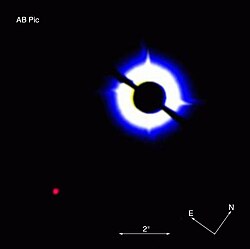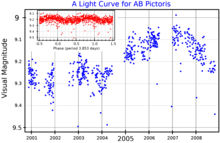 Coronagraphic image of AB Pictoris showing its tiny companion (bottom left). The data was obtained on 16 March 2003 with NACO on the VLT, using a 1.4 arcsec occulting mask on top of AB Pictoris. | |
| Observation data Epoch J2000.0 Equinox J2000.0 | |
|---|---|
| Constellation | Pictor |
| Right ascension | 06h 19m 12.913s[1] |
| Declination | −58° 03′ 15.53″[1] |
| Apparent magnitude (V) | 9.13[2] (9.21 to 9.35)[3] |
| Characteristics | |
| Spectral type | K1V(e)[2] |
| B−V color index | 0.861±0.027[4] |
| Variable type | BY Dra[3] |
| Astrometry | |
| Radial velocity (Rv) | 22.6±0.3[2] km/s |
| Proper motion (μ) | RA: 14.314±0.015 mas/yr[1] Dec.: 45.234±0.017 mas/yr[1] |
| Parallax (π) | 19.9452 ± 0.0124 mas[1] |
| Distance | 163.5 ± 0.1 ly (50.14 ± 0.03 pc) |
| Absolute magnitude (MV) | 5.82[4] |
| Details | |
| Mass | 0.90±0.10[5] M☉ |
| Radius | 0.92±0.03[6] R☉ |
| Luminosity | 0.51[4] L☉ |
| Surface gravity (log g) | 4.67±0.09[5] cgs |
| Temperature | 5,188±50[6] K |
| Metallicity [Fe/H] | −0.54[4] dex |
| Rotation | 3.90±0.08 d[7] |
| Rotational velocity (v sin i) | 10.87±0.08[7] km/s |
| Age | 30–40[8] Myr |
| Other designations | |
| Database references | |
| SIMBAD | data |
AB Pictoris (abbreviated AB Pic, also catalogued as HD 44627) is a K-type main-sequence star, located 163.5 light-years away in the southern constellation of Pictor.[1] It has been identified as a member of the young (30 million years old) Tucana–Horologium association.[10] The star has been classified as a BY Draconis variable,[3] indicating it has an active chromosphere. It is an X-ray source and displays emission lines in its spectrum.[11][2]
In 2005 it was announced that an astronomical object (AB Pictoris b, abbreviated AB Pic b) had been imaged in 2003 and 2004 close to and apparently in orbit around the star. Its mass suggests that it is at the borderline between being a brown dwarf or a planet.[12]

- ^ a b c d e Cite error: The named reference
GaiaDR3was invoked but never defined (see the help page). - ^ a b c d Cite error: The named reference
Torres2006was invoked but never defined (see the help page). - ^ a b c Cite error: The named reference
Samus_et_al_2017was invoked but never defined (see the help page). - ^ a b c d Cite error: The named reference
Anderson_Francis_2012was invoked but never defined (see the help page). - ^ a b Cite error: The named reference
Ghezzi_et_al_2010was invoked but never defined (see the help page). - ^ a b Cite error: The named reference
van_Belle_von_Braun_2009was invoked but never defined (see the help page). - ^ a b Cite error: The named reference
Bowler_et_al_2023was invoked but never defined (see the help page). - ^ Cite error: The named reference
neu05was invoked but never defined (see the help page). - ^ Cite error: The named reference
sb0was invoked but never defined (see the help page). - ^ Inseok Song, B. Zuckerman; Bessell, M. S. (December 2003). "New Members of the TW Hydrae Association, β Pictoris Moving Group, and Tucana/Horologium Association". The Astrophysical Journal. 599 (1): 342–350. Bibcode:2003ApJ...599..342S. doi:10.1086/379194. S2CID 51833191..
- ^ Cite error: The named reference
Haakonsen_Rutledge_2009was invoked but never defined (see the help page). - ^ Cite error: The named reference
chauvinwas invoked but never defined (see the help page). - ^ Cite error: The named reference
Kiragawas invoked but never defined (see the help page).